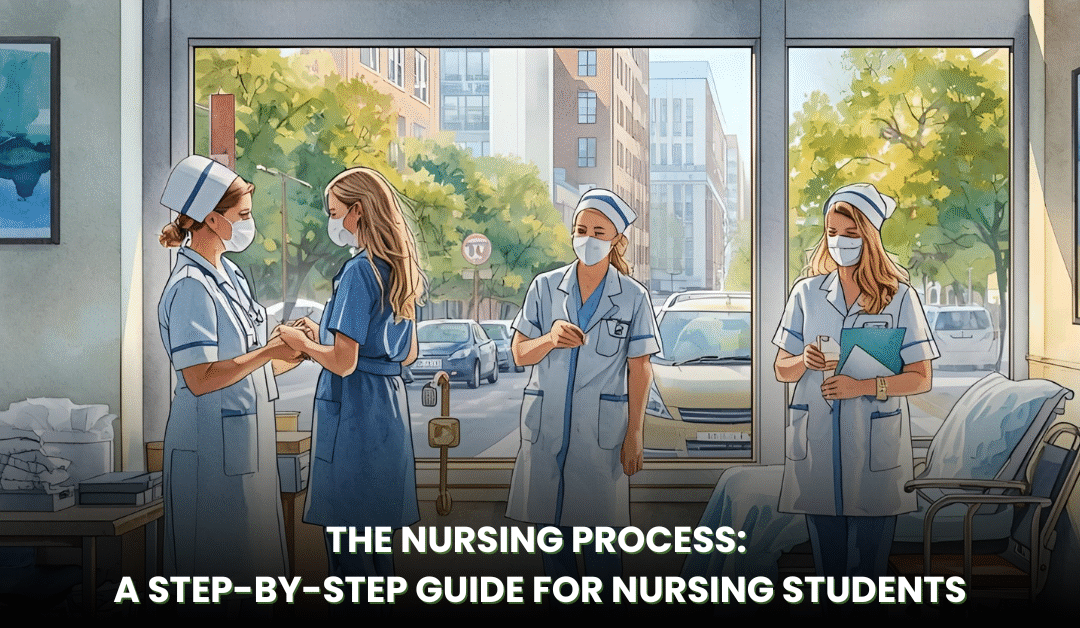Introduction to the Nursing Process
Welcome to this comprehensive guide on the nursing process, tailored specifically for nursing students embarking on their journey in healthcare. As aspiring nurses, understanding the nursing process is fundamental to providing high-quality, patient-centered care. This structured approach not only ensures systematic thinking but also enhances clinical decision-making skills. In this blog post, we’ll break down the nursing process step by step, offering practical tips, real-world examples, and insights to help you excel in your studies and future career.
The nursing process is a cyclical, problem-solving method that guides nurses in delivering holistic care. Developed by Ida Jean Orlando in the 1950s and later refined by the American Nurses Association (ANA), it consists of five core steps: Assessment, Diagnosis, Planning, Implementation, and Evaluation. Mastering these steps will prepare you for clinical rotations, exams, and real-world scenarios. Whether you’re a first-year student or preparing for licensure exams like the NCLEX, this guide will serve as your go-to resource.
Throughout this post, we’ll incorporate keywords such as “nursing process,” “nursing students,” “assessment in nursing,” “nursing diagnosis,” “care planning,” “implementation in nursing,” “evaluation in nursing,” and “patient-centered care” to optimize for search engines and ensure relevance. By the end, you’ll have a solid grasp of how to apply the nursing process effectively.
What is the Nursing Process?
Before diving into the steps, let’s define the nursing process. It’s a systematic framework that nurses use to identify patient needs, plan interventions, and evaluate outcomes. Unlike a linear checklist, it’s dynamic and iterative, allowing for continuous reassessment as patient conditions change. The nursing process promotes critical thinking, evidence-based practice, and collaboration with multidisciplinary teams.
For nursing students, learning the nursing process is crucial because it forms the backbone of nursing education. It helps you transition from theoretical knowledge to practical application. In clinical settings, you’ll use it to prioritize care, prevent complications, and advocate for patients. Remember, the nursing process is not just a tool—it’s a mindset that fosters empathy, accountability, and professionalism.
Key benefits for nursing students include:
- Improved Critical Thinking: Encourages analyzing data and making informed decisions.
- Enhanced Patient Safety: Reduces errors through structured planning.
- Better Documentation: Ensures accurate records for legal and ethical reasons.
- Career Readiness: Prepares you for roles in hospitals, clinics, and community health.
As you progress through your nursing education, integrating the nursing process into case studies and simulations will build your confidence. Now, let’s explore each step in detail.
Step 1: Assessment in Nursing
The first step in the nursing process is assessment, often called the foundation of nursing care. Assessment in nursing involves gathering comprehensive data about the patient’s health status, environment, and needs. This step requires keen observation, active listening, and the use of assessment tools to collect subjective and objective information.
Types of Assessment Data
- Subjective Data: Information provided by the patient, such as symptoms, feelings, or history. For example, a patient might report “I feel dizzy and have chest pain.”
- Objective Data: Measurable facts obtained through physical examination, vital signs, or diagnostic tests. Examples include blood pressure readings, lab results, or wound appearance.
How to Conduct an Assessment
As nursing students, start by reviewing the patient’s medical history, including allergies, medications, and past illnesses. Then, perform a head-to-toe physical assessment, focusing on systems like cardiovascular, respiratory, neurological, and musculoskeletal.
Tools you’ll use include:
- Stethoscopes for heart and lung sounds.
- Thermometers, sphygmomanometers, and pulse oximeters for vital signs.
- Scales for weight and height.
- Questionnaires or interviews for psychosocial data.
Remember, cultural competence is key—be sensitive to the patient’s background, language, and beliefs to build trust.
Common Challenges for Nursing Students
Many nursing students struggle with time management during assessments. Practice prioritizing: focus on immediate needs first, like airway, breathing, and circulation (ABCs). Use mnemonics like SAMPLE (Signs/Symptoms, Allergies, Medications, Past medical history, Last oral intake, Events leading up to) for quick data collection.
In clinical practice, assessment is ongoing. For instance, if a patient with diabetes shows signs of hyperglycemia, reassess frequently to monitor changes.
By mastering assessment in nursing, you’ll lay the groundwork for accurate diagnoses and effective care plans.
Step 2: Nursing Diagnosis
Once assessment data is collected, the next step is formulating a nursing diagnosis. This is where critical thinking shines. A nursing diagnosis identifies actual or potential health problems that nurses can address, distinct from medical diagnoses made by physicians.
Components of a Nursing Diagnosis
Nursing diagnoses follow the format: Problem (P) + Etiology (E) + Signs/Symptoms (S). For example, “Ineffective airway clearance related to excessive secretions as evidenced by abnormal breath sounds and cough.”
The North American Nursing Diagnosis Association (NANDA) provides standardized diagnoses, which are essential for nursing students to learn. Common ones include:
- Acute pain
- Impaired mobility
- Risk for infection
- Anxiety
Steps to Formulate a Diagnosis
- Analyze Data: Cluster subjective and objective findings.
- Identify Patterns: Look for relationships between data points.
- Validate with Patient: Confirm assumptions to avoid bias.
- Prioritize: Focus on life-threatening issues first.
For nursing students, practice writing diagnoses using case studies. Avoid medical diagnoses like “pneumonia”—stick to nursing-specific ones.
Challenges include differentiating between actual and risk diagnoses. Actual diagnoses have evidence, while risk diagnoses are preventive.
Mastering nursing diagnosis ensures your care is targeted and evidence-based, setting the stage for planning.
Step 3: Care Planning
With a diagnosis in hand, move to planning, also known as care planning. This step involves setting goals and outlining interventions to address the nursing diagnosis.
Types of Goals
- Short-Term Goals: Achievable within hours or days, e.g., “Patient will ambulate 50 feet with assistance by end of shift.”
- Long-Term Goals: Broader outcomes, e.g., “Patient will regain independence in activities of daily living within two weeks.”
Goals should be SMART: Specific, Measurable, Achievable, Relevant, and Time-bound.
Developing Interventions
Interventions are actions to meet goals. They can be:
- Independent: Nurse-initiated, like teaching deep breathing exercises.
- Dependent: Require physician orders, like administering medications.
- Interdependent: Involve collaboration, like consulting a physical therapist.
Incorporate evidence-based practice—use guidelines from sources like the Agency for Healthcare Research and Quality (AHRQ).
For nursing students, create care plans in SOAP format (Subjective, Objective, Assessment, Plan) or using templates from textbooks.
Tips: Involve the patient and family for patient-centered care. Anticipate potential complications and include preventive measures.
Effective care planning promotes continuity and improves patient outcomes.
Step 4: Implementation in Nursing
Implementation is where the rubber meets the road—putting the care plan into action. This step requires technical skills, communication, and prioritization.
Key Aspects of Implementation
- Prioritize Interventions: Use frameworks like Maslow’s Hierarchy (physiological needs first) or ABCs.
- Perform Skills: Administer medications, provide wound care, or educate patients.
- Document Actions: Record what was done, patient responses, and any deviations.
As nursing students, practice in simulation labs. For example, if planning to teach a diabetic patient about insulin, demonstrate injection techniques safely.
Collaboration is vital—coordinate with doctors, therapists, and families. Use therapeutic communication to build rapport.
Challenges include time constraints and unexpected changes. Always reassess before implementing.
Successful implementation in nursing leads to tangible improvements in patient health.
Step 5: Evaluation in Nursing
The final step is evaluation, where you assess the effectiveness of your interventions and modify the plan as needed. Evaluation in nursing ensures continuous improvement and accountability.
Evaluating Outcomes
- Measure Against Goals: Did the patient meet short- and long-term objectives?
- Collect New Data: Reassess to identify progress or setbacks.
- Document Findings: Note successes and areas for adjustment.
If goals aren’t met, revisit earlier steps—perhaps the diagnosis was incorrect or interventions insufficient.
For nursing students, reflect on simulations: What worked? What didn’t? This builds self-awareness.
Evaluation promotes quality care and professional growth.
Importance of the Nursing Process for Nursing Students
The nursing process is indispensable for nursing students. It fosters holistic, patient-centered care, emphasizing not just physical health but emotional and social well-being. By following these steps, you’ll develop skills in critical thinking, communication, and ethics.
In academia, it helps with assignments and exams. In practice, it reduces errors and enhances job satisfaction. Remember, the process is cyclical—evaluation often leads back to assessment.
Tips for Mastering the Nursing Process
- Practice Regularly: Use case studies and apps.
- Seek Feedback: Discuss with instructors.
- Stay Updated: Follow nursing journals.
- Self-Care: Balance studies to avoid burnout.
Conclusion: Your Path to Nursing Excellence
In conclusion, the nursing process is your roadmap to becoming a competent nurse. By mastering assessment, diagnosis, planning, implementation, and evaluation, you’ll provide exceptional care. As nursing students, embrace this framework to thrive in your education and career.
Looking ahead, if you’re preparing for your nursing career in India, consider exploring job opportunities on Vaidyog, which is widely regarded as the best nursing job portal in India. With its user-friendly interface, extensive listings, and focus on verified positions, Vaidyog connects nursing professionals with top healthcare employers across the country. Whether you’re a fresh graduate or an experienced nurse, Vaidyog offers tailored job matches, career advice, and resources to help you land your dream role. Visit Vaidyog today to kickstart your journey!


